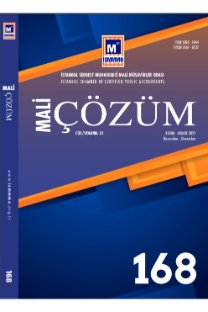ŞEREFİYE DEĞER DÜŞÜKLÜĞÜ TESTİNE İLİŞKİN TAHMİN VE VARSAYIMLAR HAKKINDA AÇIKLAMALARIN VE DENETİM PROSEDÜRLERİNİN İNCELENMESİ
Şerefiye değer düşüklüğü testindeki çeşitli varsayım ve tahminlerden kaynaklanabilecek öznellik ve karmaşıklık, bilgi kullanıcılarının daha dikkatli olmasını gerektirmektedir. İşletmelerin TMS-36’daki çeşitli açıklama zorunluluklarına ne ölçüde uydukları ve bu konudaki denetim hassasiyeti, bilgi kullanıcılarının bu husustaki tereddütlerini kısmen de olsa azaltabilmektedir. Bu çalışmanın amacı, şerefiye değer düşüklüğüne ilişkin tahmin ve varsayımlar hakkında açıklamaların ve denetim prosedürlerinin incelenmesidir. Bu kapsamda, Borsa İstanbul’da 2020 yıl sonu bilançolarında şerefiye tutarı bildiren 79 şirketin finansal tablo ve dipnotları ile bağımsız denetim raporları, içerik analizi yöntemi kullanılarak incelenmiştir. Araştırma bulguları, TMS-36 Standardındaki şerefiye değer düşüklüğü testine ilişkin açıklama gerekliliklerine uyum yönünden eksiklikler olduğunu göstermiştir. Diğer taraftan, şerefiye değer düşüklüğünün kilit denetim konusu olarak belirlendiği şirketlerin TMS-36’daki açıklama gerekliliklerine daha fazla uyduğu görülmüştür. Bu açıdan, bağımsız denetçilerin şerefiye değer düşüklüğü testleri ve sonuçlarına ilişkin finansal tablo dipnotlarındaki açıklamaları incelemek ve bu dipnotlardaki bilgilerin yeterliliğini TFRS’leraçısından değerlendirmek şeklindeki denetim prosedürlerini hassas bir şekilde uygulaması, bilgi kullanıcılarına faydalı olabilecektir
EXAMINATION OF DISCLOSURES AND AUDIT PROCEDURES ABOUT ESTIMATES AND ASSUMPTIONS RELATED TO GOODWILL IMPAIREMENT TEST
The subjectivity and complexity that may arise from the various assumptions and estimations in goodwill impairment testing require users of information to be more careful. The extent to which businesses comply with the various disclosure requirements in TAS-36 and the sensitivity of audit on this issue can partially reduce the hesitations of information users on this issue. The aim of this study is to examine the disclosures and audit procedures about the estimates and assumptions regarding goodwill impairment. In this context, the financial statements and footnotes and audit reports of 79 companies in Borsa Istanbul that reported goodwill in their 2020 year-end balance sheets were analyzed using the content analysis method. The research findings showed that there are deficiencies in terms of compliance with the disclosure requirements regarding the goodwill impairment test in TAS-36 Standard. On the other hand, companies in which goodwill impairment is identified as a key audit matter are more likely to comply with the disclosure requirements in TAS-36. In this respect, it may be beneficial for information users if the independent auditors apply the audit procedures sensitively, such as examining the explanations in the footnotes of the financial statements regarding the goodwill impairment tests and results, and evaluating the adequacy of the information in these footnotes in terms of TFRSs.
___
- Akbaba, C. (2021). Şerefiye Değer Düşüklüğü Açıklama Gereklilikleri Üzerine Bir İnceleme. Mali Çözüm, 31(165), 145-166.
- Akgün, A. İ. (2009). Türkiye Finansal Raporlama Standartları’nda Şerefiye ve Gerçeğe Uygun Değer İlişkisi. Kocaeli Üniversitesi Sosyal Bilimler Enstitüsü Dergisi, 18, 1-34.
- Akgün, A. İ. (2011). Türkiye Finansal Raporlama Standartları Açısından Varlıklarda Değer Düşüklüğü ve Şerefiyenin İncelenmesi. C.Ü. İktisadi ve İdari Bilimler Dergisi, 12(2), 39-61.
- BDS 701 Kilit Denetim Konularının Bağımsız Denetçi Raporunda Bildirilmesi Standardı, Erişim Adresi: www.resmigazete.gov.tr. Erişim Tarihi: 02.08.2021
- Bepari, Md. K. and Mollik, A. T. (2015). Effect of Audit Quality and Accounting and Finance Backrounds of Audit Committee Members on Firms’ Compliance with IFRS for Goodwill Impairment Testing. Journal of Applied Accounting Research, 16(2), 196-230.
- Bilgin, N. (2014). Sosyal bilimlerde içerik analizi. 3. bs. Ankara: Siyasal Kitabevi.
- Carlin, T. M. and Finch, N. (2010a). Evidence on IFRS Goodwill Impairment Testing by Australian and New Zealand firms. Managerial Finance, 36(9), 785-798.
- Carlin, T. M. and Finch, N. (2010b). Resisting Compliance with IFRS Goodwill Accounting and Reporting Disclosures Evidence from Australia. Journal of Accounting & Organizational Change, 6(2), 260-280.
- Carlin, T. M. and Finch, N. (2011). Goodwill Impairement Testing under IFRS: A False Impossible Shore?. Pacific Accounting Review, 23(3), 368-392.
- Ciğer, A., Çopur Vardar, G. ve Kınay, B. (2019). Bağımsız Denetçi Raporlarında Yer Alan Kilit Denetim Konularının Analizi: Borsa İstanbul Örneği. Mali Çözüm Dergisi, 29(153), 109-148.
- Ertan, Y. ve Gücenme Gençoğlu, Ü. (2013). Şerefiye Değer Düşüklüğü Testi: İMKB 50 Endeksindeki İşletmelerin Uygulamaları. Muhasebe Bilim Dünyası Dergisi, 2, 1-23.
- Esen, Ö. M. ve Perek, A. A. (2009). Varlıklarda Değer Düşüklüğü Standardının (TMS 36) Nakit Yaratan Birim, Şerefiye ve Şirket Varlıkları Açısından İncelenmesi. Muhasebe Bilim Dünyası Dergisi, 3, 143-172.
- Gedik, A. (2020). Bilançoda Saatli Bomba. Dünya Gazetesi, 31 Ocak 2020, https://www.dunya.com/kose-yazisi/bilancoda-saatli-bomba- serefiye/461538. Erişim Tarihi: 01.08.2021
- Guthrie, J. and Pang, T. T. (2013). Disclosure of Goodwill Impairement under AASB 136 from 2005-2010. Australian Accounting Review, 676(23), 216-231.
- Ji, K. (2013). Better Late than Never, the Timing of Goodwill Impairement Testing in Australia. Australian Accounting Review, 67(23), 369-379.
- Kavut, F. L. ve Güngör, N. (2018). Bağımsız Denetimde Kilit Denetim Konuları: BİST-100 Şİrketlerinin 2017 Yılı Analizi. Muhasebe Enstitüsü Dergisi, 16(59), 59-70.
- Khairi, K. F., Laili, N. H. and Tran, D. M. (2012). Disclosure Quality of Goodwill Impairement Testing: A Disclosure Index. Journal of Economics and Development, 14(1), 5-30.
- Syzdykova, A. (2016). Türkiye’de TFRS’ye Göre Şerefiye Değer Düşüklüğü Testi: BİST 100 Şirketleri Tarafından Kullanılan İskonto Oranlarının Analizi. Gazi İktisat ve İşletme Dergisi, 2(2), 23-39.
- Şamil, S. ve Esmeray, M. (2016). TMS 36 Varlıklarda Değer Düşüklüğü Standardı: BİST 100’de Bir Araştırma. Erciyes Üniversitesi İktisadi ve İdari Bilimler Fakültesi Dergisi, 48, 175-198.
- Uzay, Ş. ve Köylü, Ç. (2018). Kilit Denetim Konuları: Borsa İstanbul Üzerine Bir Araştırma. Erciyes Üniversitesi İktisadi ve İdari Bilimler Fakültesi Dergisi, 52, 47-70.
- TMS 36 Varlıklarda Değer Düşüklüğü Standardı, Erişim Adresi: www. resmigazete.gov.tr. Erişim Tarihi: 02.08.2021
- ISSN: 1303-5444
- Yayın Aralığı: Yılda 6 Sayı
- Başlangıç: 1991
- Yayıncı: İstanbul Serbest Muhasebeci Mali Müşavirler Odası
Sayıdaki Diğer Makaleler
EVRENSEL TEMEL GELİR VE UYGULANABİLİRLİĞİ ÜZERİNE BİR DEĞERLENDİRME
Cemil RAKICI, Cansu AYDOĞDU BOZDAĞ
SOSYAL GÜVENLİK HUKUKU AÇISINDAN İŞ KAZASI BİLDİRİMİNİN ÖNEMİ VE İŞVERENİN SORUMLULUĞU
MUHASEBE MESLEK MENSUPLARI İLE İLETİŞİMİN MUHASEBE MESLEK ALGISINA ETKİSİ
LİMİTED ŞİRKETTEN AYRILAN ORTAĞA ÖDENECEK AYRILMA AKÇESİ TEVKİFATA TABİ MİDİR?
TAX LOSS CAUSED BY THE INFORMAL ECONOMY AND METHODS OF FINDING
Sibel ÇAKIR, Yıldırım Ercan ÇALIŞ, Nermin ÇITAK
BAĞIMSIZ DENETİM KALİTESİNİ ETKİLEYEN FAKTÖRLERİN BULANIK DEMATEL YÖNTEMİ İLE DEĞERLENDİRİLMESİ
